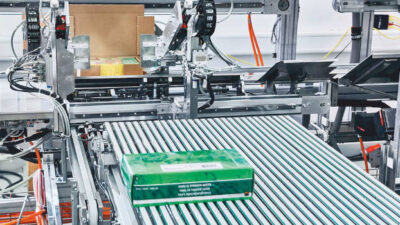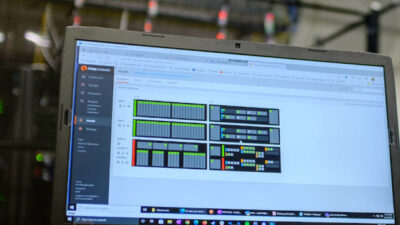A multi-phase project led to a customized, cost-effective, reliable solar-powered automated gas distribution regulator monitoring system from Huffman Engineering, which improved the safety of Nebraska’s Metropolitan Utilities District (MUD) gas system.
America’s natural gas utilities operate 2.5 million miles of distribution and transmission pipelines that span the country to provide service to more than 177 million Americans. Natural gas utilities are part of the communities in which they operate. Their mission of keeping customers safe, secure, and informed is paramount.
Like other utilities across the country, Nebraska’s Metropolitan Utilities District (MUD) is tasked with the challenge of addressing the sustainability of aging infrastructure. MUD is the fifth-largest public gas utility in the U.S., providing natural gas to more than a quarter of a million customers in the cities of Omaha, Bennington, Fort Calhoun, Springfield, Yutan, and Bellevue.
Huffman Engineering has been a trusted advisor to MUD for more than 20 years. "We count on Huffman Engineering’s expertise in control systems and technology to guide our infrastructure upgrades. The reliability and responsive willingness to answer our calls any time of the day or night has contributed to a partnership that keeps the communities we serve safe," said Jim Bewley, MUD gas distribution foreman.
The problem
In 2005, each of MUD’s 280 remote gas regulator stations had a pole-mounted enclosure containing a mechanical paper chart recorder to monitor inlet and outlet pressures (see Figure 1). The chart recorders could record three to seven days of the regulator pressure reading data. Every 48 hours or on a weekly basis, the charts were changed manually and examined by MUD employees solely dedicated to this responsibility.
Not only was this antiquated and labor-intensive, the fact that data was not analyzed for up to a week was a major concern for MUD in terms of emergency response time to correct abnormal operating conditions. MUD wanted to be able to monitor the remote stations in real time and have the information display on the supervisory control and data acquisition (SCADA) system at their system control headquarters.
The journey to the solution
Replacing the paper chart recorders began in 2005 with just five pilot locations. MUD relied on Huffman Engineering as a partner and advisor during the five-phase project with automation of the final set of regulator stations taking place in 2017. Huffman Engineering’s role included design of the control panels and installation of the new hardware to transmit the pressure readings to MUD’s system control SCADA system. Huffman Engineering programmed the SCADA system software to integrate the new centralized data collection with display, alarm, trend, historical logging, and report capabilities.
Jim Bewley summarized the benefits of automation gas distribution sites, "The cost savings has been substantial. More importantly, the safety and security of the communities we serve has improved through a reliable automated monitoring system where problems are reported within 15 minutes rather than potentially taking up to seven days."
Challenges along the way
Cost: With the pilot sites, the major cost was for the electrical contractor. The local electric utility company connected power to the site free of charge. However, when researching the conversion for the next set of sites, electric power was not readily available, so the costs were considerably higher. The cost to have the electric utility and electrical contractor bring in electricity ranged in cost from $10,000 to $20,000 per site, depending on distance and difficulty in reaching the site. This made it cost-prohibitive for MUD. These locations required an off-grid solution to power the equipment.
Alternative power—poor fit: After several initial solar installations, MUD continued to search for the optimal solution. For the monitoring sites located in publicly-accessible areas, the solar arrays (panels) would stand out because of their size. One alternative solution tested was a thermoelectric battery charger, which is a small device that does not stand out like a solar array. The thermoelectric battery charger uses natural gas to create a temperature differential that is then converted to electricity. Because natural gas is available at each of the regulator sites, it made sense to try it. However, the thermoelectric device worked for a couple months and then failed due to internal corrosion. MUD determined the thermoelectric battery charger was not a good long-term solution for this application.
A lengthy process: The plan to replace all the manual chart recorders was scheduled to take place in phases, with one phase installed per year. Six or seven months are needed to complete each phase, which comprises a set of 50 to 60 sites. The process includes site prep work and gas line piping to connect the transmitters, a lengthy bidding and selection procedure, parts procurement, panel building, installation, and testing.
The solution highlights
Solar-powered site hardware: The hardware consists of a pole with a mounted enclosure for a remote terminal unit (RTU), modem, charge controller, battery, mounted enclosure containing the pressure transmitter(s), and solar panel mounted on the top of the pole (see Figure 2). The RTU input/output points include pressure readings, battery voltage, and heartbeat data.
SCADA system at MUD’s system control: By removing nearby or redundant sites, the scope of the project was reduced to upgrading 225 monitoring locations. All stations are monitored at MUD’s system control, which is manned by a system-control operator 24 hours a day. The RTUs are programmed to collect pressure data every 15 minutes and under normal conditions, they will report pressure readings every four hours to the SCADA system. If the pressure goes out of range, the RTUs will report the pressure readings within 15 minutes to the SCADA system. The pressure is alarmed on the SCADA screen to alert the operator with a Hi, Hi/Hi, Low, and Low/Low status. The operator then can report the problem to a supervisor to take immediate action.
The solution benefits
Safety: According to MUD, the real-time monitoring already has alerted MUD personnel to abnormal operating conditions (pressures above or below alarm setpoints).
Daily reports: Technicians are emailed reports daily to streamline work for the day. These reports, and the ability to access historical data to see trends, allow for predictive maintenance to keep the gas regulator stations up and running (see Figure 3). The reports include:
- Site pressure alarms.
- Communication failures.
- Number of call-ins by site.
- Battery voltage in solar panel.
Consistency and ease of maintenance through standardization
- The panels are all built the same. There are only three drawing sets: one for a 1-transmitter site, 2-transmitter site, and 3-transmitter site.
- All panels have the same parts, reducing the number of spare parts to keep on-hand.
- There is no individual complex setup for the RTU programs; there are only three variations, again based on the number of transmitters.
Labor savings
- Elimination of chart technician positions (previously two employees).
- SCADA reports emailed in the morning to gas distribution personnel give direction for how to organize their day.
- Standardization of the panels allows for employees to have the right spare parts on-hand and resolve maintenance issues quickly.
Other cost savings
- Reduction in cellular data usage and power cost by programming the cellular modem to only power on when transmitting data (every four hours except in the event of an alarm condition).
- The 12-V solar charging system uses minimal power.
This project led to a cost-effective, reliable solar-powered automated gas distribution regulator monitoring system from Huffman Engineering. Huffman Engineering is proud to have contributed to the improved safety and efficiency of MUD’s gas system. Innovative, low-cost solutions such as these can be implemented throughout the U.S. to increase the sustainability of aging infrastructure.
Craig Malesker is a senior electrical engineer and project manager at Huffman Engineering Inc., in Lincoln, Neb., where he has worked since 1993. Specializing in programming control systems for a variety of industries, Malesker is trained in nine leading-edge platforms and has experience with all the major brands. Malesker graduated from the University of Nebraska-Lincoln with a bachelor of science in electrical engineering.
Sean Creager is a senior electrical engineer at Huffman Engineering Inc., where he has worked for nearly eight years. His specialty is human-machine interface (HMI) configuration, and he has completed training on five popular platforms. His HMI configuration skills include operator interface design, database design and maintenance, and web-based reporting. Creager received his bachelor of science in electrical engineering from the University of Nebraska-Lincoln, where he was part of the J.D. Edwards Honors Program.
Huffman Engineering Inc., is a CSIA certified control system integrator.
This article appears in the Applied Automation supplement for Control Engineering and Plant Engineering.
– See other articles from the supplement below.



